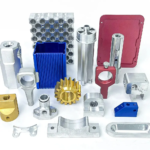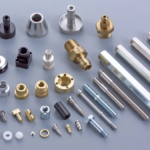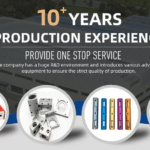Heat treatment is a post-processing technique commonly used to modify the physical or chemical properties of materials.
Annealing is one such processing method that you can find inI heard about it in the context of 3D printing. It is said to improve the performance of 3D printed parts, but how exactly does this process work and what can be achieved with PLA?
In this article, we’ll learn how annealing works and describe some procedures you can try at home.
A,What is annealing?


Microscope images of ordinary PLA and annealed at 110°C (Source: Prusa Research)
Annealing is a heat treatment used to increase the ductility of a metal and make the part easier to machine. This is done by heating the material to an ideal point below its melting point but above its recrystallization temperature.
When metal is cast or shaped it is calledThe tiny crystal structures of the “grains” make up the microstructure of the material. The smaller the grains, the harder and more brittle the material. Larger particles reduce hardness and increase ductility, making them easier to handle.
The process of annealing metals involves heating the material to a temperature that allows the grains to recrystallize and grow. The longer a material remains at this temperature, the greater its ability to change structurally.
plastic annealing and3D printing
While annealing is primarily intended for metals, a similar process is used on plastics to reduce internal stresses in injection molded parts. This is done by heating the plastic part below its melting point to allow the material to relax and reform.
butThe situation with 3D printing is a little different. The microstructure of plastics varies between amorphous (completely disordered) and highly crystalline. The crystal structure has stronger mechanical properties. Semi-crystalline materials, like PLA or PETG, contain both amorphous and crystalline regions, although their proportions depend on their thermal history.
Rapid heating and cooling of materials during the 3D printing process increases the amorphous part. Annealing 3D printed parts allows them to rearrange their molecular chains and develop crystalline regions. Like annealing the metal, this imparts stronger mechanical properties. The slight melting that occurs during the annealing process fuses the layers together, eliminating these weak spots in the printed part.
two,annealedPLA


Annealing allows you to printPLA has better heat resistance – test it! (Source: Punk guest from Thingiverse)
PLA is one of the most commonly used materials for 3D printing. It is quite easy to print and has good mechanical strength, even if it is a little brittle. However, its melting temperature is relatively low compared to other 3D printing materials.
These characteristics makePLA becomes the ideal choice for annealing. In fact, several studies have actually demonstrated improved mechanical properties after annealing PLA.
In terms of material strength, tests show that after annealingPLA parts are 10-20% stronger and generally less brittle. In terms of temperature resistance, annealed PLA also shows good results compared to other annealed materials for 3D printing.
default
The main disadvantage of annealing PLA is dimensional changes. Tests at different temperatures show that PLA changes significantly even at lower temperatures, such as 70°C, while higher temperatures (110-170°C) can cause deformation or even complete melting.
So, finally, forAnnealing 3D printed PLA is a trade-off between better material properties and dimensional or shape accuracy.
three,General advice


After annealingPLA parts will undergo some dimensional changes (Source: mdk6502 via Reddit)
In the next section, we’ll look at some methods that can be used without industrial-grade equipment.PLA annealing procedure.
to use100% infill printed parts: The denser the parts, the better they resist deformation and dimensional changes. AlthoughIt’s not common to print with 100% infill, but it certainly pays off when annealing PLA.
Make sure rooms are as clean as possible: Before annealing, clean any strings from the part, debris on the edges and supports, as well as glue residue on the part.
Use a dedicated oven thermometer: Although many modern ovens come with built-in thermometers, they can be extremely inaccurate. For pastry,5°C or even 10°C may not be that important, but when annealing plastic parts, every degree counts, especially with temperature sensitive materials like PLA.
Maintain the temperature inside the oven even: Once the oven has reached the desired temperature, wait at least30 minutes before inserting the parts.
Prepare for sizing inaccuracies: Even if it succeeds,Annealing PLA can also warp, warp, or at least change the overall dimensions of the part, so be aware of that.
If possible, use an electric oven: Although you can use a gas oven, keep in mind that they are less precise and will overheat when heating. If you only have a gas oven, you should use a thermometer.
The ideal annealing temperature for PLA can vary depending on the filament brand. Generally speaking, the glass transition temperature of PLA is 60 to 65°C and the melting temperature is around 180°C. The first experimental attempts therefore began at around 60°C. If your room ends up looking the same, increase the target temperature by 5°C until you achieve the desired results.
Four,Two annealing methods
1、sand


The pressure of the sand during annealing prevents defects such as warping (Source:goliatskipson via Reddit)
The first and most accurate method requires a little sand to ensure the heat is distributed evenly across all surfaces of the parts. Parts buried in sand also benefit from a certain mechanical support to avoid excessive physical deformation.
If you don’t have sand on hand, you can also try the same method with salt. It is best to use finely ground salt, otherwise large salt crystals may pit the surface of the workpiece. Make sure to wrap it well for best results.
For this process, we set the temperature close to the glass transition temperature to minimize distortion. It is recommended to start with a lower temperature and, if successful, increase the temperature for other batches of parts. Don’t overdo it, or you may end up with a print that has embedded sand.
Heat the oven to60°C and wait at least 30 minutes.
While the oven is heating, prepare an oven-safe container large and deep enough to hold your pieces and fill it with sand. Bury the pieces completely, leaving at least a minimum of5mm space.
Place the container with the sand and coins in the oven and leave it for an hour.
When finished, remove the container and let it cool to room temperature without removing the pieces from the sand.
Once everything has cooled, you can remove the annealed pieces from the container.
2. Finish directly in the oven


Whichever path you choose, keep an eye on the temperature and timer! (source:pyyoer, via Reddit)
Instead of using the sand or salt method, you can try annealing the parts directly in a preheated (but turned off) oven. This is a great method if your gas oven doesn’t maintain a consistent temperature. Since there is no sand, you can simply place the pieces in any type of ovenproof container.
Here, the parts are cooled inside the oven rather than outside. Since the part only exceeds the glass transition temperature for a short time, you may not be able to achieve complete annealing as with the first method. However, gradual cooling to elevated temperatures will avoid the formation of internal stresses and reduce warping.
Heat the oven to60°C and maintain this temperature for at least 30 minutes.
WillThe 3D printed part is placed on an oven-safe surface and then placed inside. Immediately turn off the oven and all heating elements inside.
Leave the print in the oven until it cools.
There is another simple annealing method


in hot waterControlling temperature when annealing PLA parts can be difficult (Source: Justin Lam)
If you don’t have access to an oven, there is another method, although it is far from ideal. Rather than providing heat directly to the components, they are immersed in hot water. Although this process should work in theory, the results are inconsistent and there are few examples online that actually work.
The idea is toPlace the 3D printed part in a sealed plastic bag (preferably a vacuum-sealed plastic bag) and place it under water to anneal it. Although a small drop of water does not affect mechanical changes, it can change the appearance of the print. This method may seem like a good idea at first, but controlling the water temperature is the tricky part.
Slow cooking equipment like a sous vide machine is great for keeping water at the right temperature and may be worth a try.
Source: ALL3DP
Daguang focuses on providing solutions such as precision CNC machining services (3-axis, 4-axis, 5-axis machining), CNC milling, 3D printing and rapid prototyping services.










